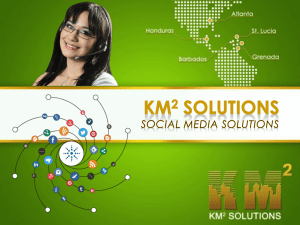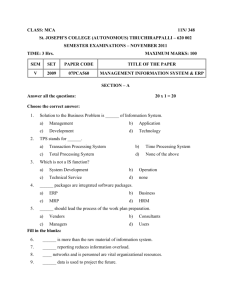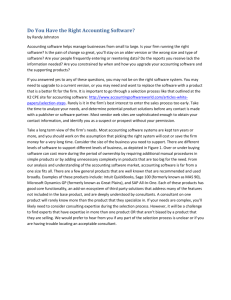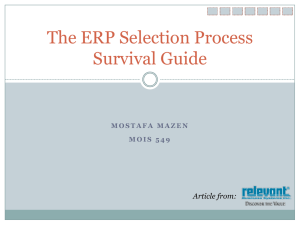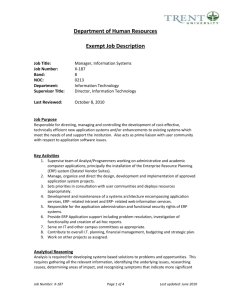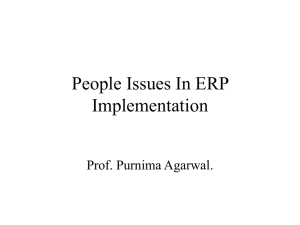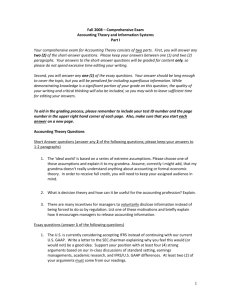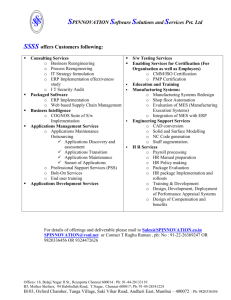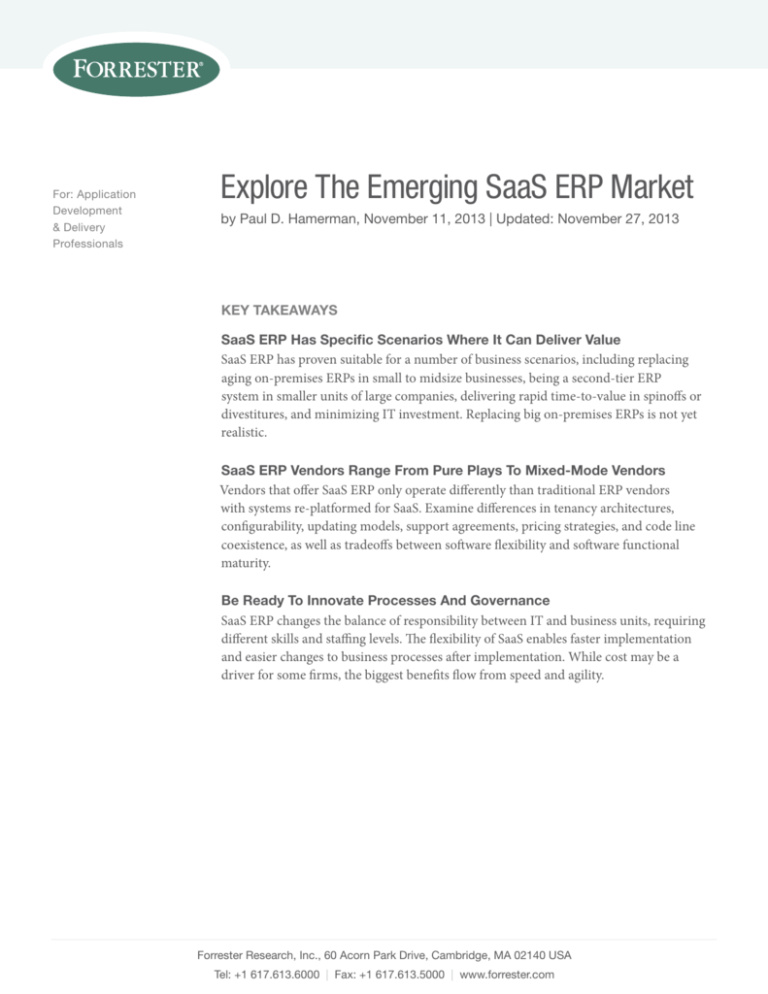
For: Application
Development
& Delivery
Professionals
Explore The Emerging SaaS ERP Market
by Paul D. Hamerman, November 11, 2013 | Updated: November 27, 2013
Key Takeaways
SaaS ERP Has Specific Scenarios Where It Can Deliver Value
SaaS ERP has proven suitable for a number of business scenarios, including replacing
aging on-premises ERPs in small to midsize businesses, being a second-tier ERP
system in smaller units of large companies, delivering rapid time-to-value in spinoffs or
divestitures, and minimizing IT investment. Replacing big on-premises ERPs is not yet
realistic.
SaaS ERP Vendors Range From Pure Plays To Mixed-Mode Vendors
Vendors that offer SaaS ERP only operate differently than traditional ERP vendors
with systems re-platformed for SaaS. Examine differences in tenancy architectures,
configurability, updating models, support agreements, pricing strategies, and code line
coexistence, as well as tradeoffs between software flexibility and software functional
maturity.
Be Ready To Innovate Processes And Governance
SaaS ERP changes the balance of responsibility between IT and business units, requiring
different skills and staffing levels. The flexibility of SaaS enables faster implementation
and easier changes to business processes after implementation. While cost may be a
driver for some firms, the biggest benefits flow from speed and agility.
Forrester Research, Inc., 60 Acorn Park Drive, Cambridge, MA 02140 USA
Tel: +1 617.613.6000 | Fax: +1 617.613.5000 | www.forrester.com
For Application Development & Delivery Professionals
November 11, 2013
Updated: November 27, 2013
Explore The Emerging SaaS ERP Market
by Paul D. Hamerman
with China Martens, Mike Gilpin, George Lawrie, and Sarah Bookstein
WHY READ THIS REPORT
Many application delivery leaders are in the process of reassessing their existing enterprise resource
planning (ERP) implementations, which may be more than a decade old, inflexible to the changing needs
of their businesses, and highly expensive to maintain. One key question facing application delivery leaders
is whether or not to continue to invest solely in on-premises ERP or to complement (or even fully replace)
the current software with a different deployment option — software-as-a-service (SaaS) ERP. This report
examines this emerging SaaS ERP market, which already has several established SaaS-only players. The
market continues to expand as traditional ERP players offer SaaS products and newer entrants emerge.
The document highlights many of today’s SaaS ERP vendors, describes customers’ experiences with the
technology, and identifies a number of SaaS ERP business scenarios.
TABLE OF CONTENTS
NOTES & RESOURCES
2 Firms Today Are More Likely To Consider
SaaS ERP As A Viable Option
Forrester conducted briefings with SaaS
ERP vendors Acumatica, Epicor Software,
FinancialForce.com, Infor, NetSuite, Oracle,
Plex Systems, The Sage Group, SAP, and
Workday and sent an online SaaS ERP
questionnaire to these 10 vendors. Forrester
also interviewed 10 customers by phone who
have deployed SaaS ERP.
Speed, Flexibility, And Cost Factors Drive
SaaS Adoption
SaaS ERP Is Appropriate In Several Business
Scenarios
7 The SaaS ERP Market Is Taking Shape
SaaS ERP Players Range From Pure-Play
SaaS To Mixed-Mode Vendors
SaaS ERP Expectations Will Continue To
Evolve As Adoption Grows
recommendations
16 Put SaaS Delivery Models To The Test In
Your Evaluations
17 Supplemental Material
Related Research Documents
Don’t Just Maintain Business Applications,
Raise Business Responsiveness
June 18, 2013
Global, Industry, And Technology Forces
Shape The ERP Landscape
May 9, 2013
Rightsource Your Business Applications
Using An Agile Software Selection Approach
December 20, 2012
© 2013, Forrester Research, Inc. All rights reserved. Unauthorized reproduction is strictly prohibited. Information is based on best available
resources. Opinions reflect judgment at the time and are subject to change. Forrester®, Technographics®, Forrester Wave, RoleView, TechRadar,
and Total Economic Impact are trademarks of Forrester Research, Inc. All other trademarks are the property of their respective companies. To
purchase reprints of this document, please email clientsupport@forrester.com. For additional information, go to www.forrester.com.
For Application Development & Delivery Professionals
2
Explore The Emerging SaaS ERP Market
FIRMS TODAY ARE MORE LIKELY TO CONSIDER SAAS ERP AS A VIABLE OPTION
Application development and delivery professionals and their peers have traditionally seen softwareas-a-service (SaaS) enterprise resource planning (ERP) applications as a good fit for startup operations
and established small to midsize businesses.1 However, application delivery teams have tended
to consider SaaS ERP as less appropriate for the often more complex needs of larger firms.2 This
perception is eroding at a faster pace than a few years ago, thanks, in part, to the successful deployment
of SaaS customer relationship management (CRM) and human capital management (HCM), where
enterprises may have tens of thousands of users accessing their SaaS applications. At the same time,
more enterprises are considering how to better meet the needs of their subsidiaries or smaller business
units and wondering if SaaS ERP might be the answer they’ve been seeking.3 Forrester’s survey-based
research revealed that firms’ opinions about SaaS adoption have changed quickly over the course of a
single year (see Figure 1).
Speed, Flexibility, And Cost Factors Drive SaaS Adoption
Many application delivery professionals want to educate themselves about the business and
technology pros and cons of implementing SaaS ERP applications and the vendors and products on
offer in today’s market. Results from our survey-based market research, as well as from numerous
client inquiries, indicate that several key factors are driving SaaS adoption (see Figure 2):
■ Speed of implementation improves with SaaS. Our survey data indicates that speed of
implementation is a key benefit realized from SaaS. Product comparisons in our Forrester Wave™
evaluations as well as discussions with software vendors, systems integrators, and customers
validate this premise. Implementation results will vary based on software architectures and
complexity of requirements, but customers can reasonably expect significant reductions in
implementation time and cost with products natively designed for SaaS versus traditional onpremises ERP systems.
■ Applications built for SaaS are typically designed for greater flexibility. Rather than
customizing the applications in the underlying code, most SaaS products are more easily
adaptable in the metadata layer without programming customizations or extensions. Yet some
SaaS products (e.g., NetSuite, salesforce.com, SAP Business ByDesign) also expose a platformas-a-service (PaaS) layer that enables extension of the SaaS application, including the ability of
partners to add prebuilt extensions for certain industries.
■ SaaS applications are easier to upgrade. With more frequent upgrades, SaaS customers are
typically on the latest release of the software, avoiding the version lag that is very common with
on-premises software. With SaaS, vendors usually push the software updates automatically to
all customers, and customers are obliged to accept them, although they may choose whether or
not to activate the new features. Customers desiring more control over software versioning may
choose an ERP vendor that provides dedicated tenancy in a hosted environment. While this is
often referred to as “cloud,” it is different than true multitenant SaaS.
© 2013, Forrester Research, Inc. Reproduction Prohibited
November 11, 2013 | Updated: November 27, 2013
For Application Development & Delivery Professionals
3
Explore The Emerging SaaS ERP Market
■ Ownership costs are more predictable. The “all in” cost model of SaaS includes application
maintenance, software use, hosting, and upgrades for a flat subscription fee. This is a simpler
and more predictable cost model than on-premises ERP, where customers also need to factor in
costs of hardware, platform software, and software upgrades, in addition to maintenance fees.
Forrester has found that many ERP customers typically defer on-premises software upgrades for
several years, resulting in cost spikes when they do eventually upgrade.
Figure 1 Firms Are Rethinking Their SaaS ERP Plans
“What are your firm’s plans to use software-as-a-service (SaaS) to complement or
replace the following applications?”
Using/planning to supplement, Q4 2011
Using/planning to supplement, Q4 2012
Replaced/plan to replace, Q4 2011
Replaced/plan to replace, Q4 2012
25%
CRM
19%
20%
Project portfolio management
Business process management
16%
19%
16%
16%
11%
16%
17%
15%
Order management
14%
14%
SCM
11%
14%
Enterprise asset management
12%
14%
Finance and accounting
33%
9%
13%
Business intelligence
11%
12%
ERP
9%
12%
40%
29%
31%
24%
23%
ePurchasing
PLM
25%
28%
22%
25%
Collaboration software
Industry-specific software
30%
30%
31%
24%
29%
Human capital management
Content management
32%
34%
30%
33%
Learning management
26%
30%
26%
30%
32%
37%
23%
27%
27%
33%
21%
26%
22%
27%
21%
25%
18%
23%
27%
30%
21%
26%
Base: 2,220 (2012) and 2,198 (2011) software decision-makers from firms with 20 or more employees
Source: Forrsights Software Survey, Q4 2011 and Q4 2012
99021
© 2013, Forrester Research, Inc. Reproduction Prohibited
Source: Forrester Research, Inc.
November 11, 2013 | Updated: November 27, 2013
For Application Development & Delivery Professionals
4
Explore The Emerging SaaS ERP Market
Figure 2 Companies Look To SaaS To Improve Agility And Speed
“How important were the following benefits in your firm's decision to use SaaS?”
(4 and 5 responses on a scale of 1 [not at all important] to 5 [very important])
Speed of implementation and deployment
72%
Improved business agility
69%
Allows us to focus resources on
more important projects
Support business innovation with new capabilities
68%
64%
Faster delivery of new features and functions
from SaaS/as-a-service providers
Lower overall costs
57%
55%
Ability to substitute upfront costs
with regular monthly payments
41%
Base: 1,224 software decision-makers at firms with at least 100 employees
Source: Forrsights Software Survey, Q4 2012
Source: Forrester Research, Inc.
92741
SaaS ERP Is Appropriate In Several Business Scenarios
Established SaaS ERP customers demonstrate a number of specific SaaS ERP use cases or business
scenarios, each with their own set of drivers and benefits. The scenarios vary based on business
events and deployment models. Based on our analysis, we find that key SaaS ERP deployment
patterns include the following scenarios:
■ Setting up a new business operation. When an enterprise is establishing a brand-new line of
business or expanding its operations to a fresh geography, both time-to-market and cost are
key considerations. For many firms, the time and cost to roll out the corporate standard, onpremises ERP to a new unit or territory is prohibitive. Typically, new operations of relatively
small scale can be supported much more quickly with simpler, easier-to-use SaaS solutions.
“SaaS is the way to go forward. It’s less of a noose around the business’ neck. We get speed to
market, and we don’t have to build a massive data center in a new geography and spend so
long re[egarding] legalities to invest all the moneys up front. We can focus the learning on
the right stuff — our brand.” (Director, IT, multichannel retailer of home goods)
© 2013, Forrester Research, Inc. Reproduction Prohibited
November 11, 2013 | Updated: November 27, 2013
For Application Development & Delivery Professionals
5
Explore The Emerging SaaS ERP Market
■ Minimizing IT resource and capital investments. In this scenario, a firm wants to limit
investment in maintaining its own IT operations for supporting typical ERP functions (e.g.,
finance, HR, sales, procurement), so it can focus scarce IT resources on the differentiating
aspects of the business, such as the revenue stream and operational execution. SaaS enables
these companies to focus their technical resources and infrastructure investment on missioncritical operations, rather than the back office.
“The drivers for the SaaS decision were: Concentrate on our focus — we didn’t want to
support functions where we were not expert, for example, in running server farms and
bolting on ERP and trying to self-support programs. With SaaS, we could always be on the
same platform as it evolves, and we could bring in a different type of person to support it
and move away from IT coders.” (Controller, US motor club)
■ A business event setting a deadline for systems changes. A spinoff or divesture is a typical
scenario that requires a systems deployment to happen quickly. SaaS ERP is a good fit when the
new business entity has to adhere to an established date for going live on its own systems. The
new entity, in a spinoff scenario, will no longer have access to the parent’s business applications
as of a specific date and needs to move quickly to adopt a new ERP system.
“Our sister company cut us off, we had no access to that system anymore — it was like the
electricity company turning off the lights. After the divestment, we had a lot of new hires.
There was good and bad about that. It was good that everyone was not tainted with what
the old system had done versus it was bad that operational knowledge was lost. We were
missing tribal knowledge meaning people didn’t know what wasn’t there compared to the
old system.” (Controller, US motor club)
■ Standardizing on a two-tier ERP architecture. This key scenario may involve new and/or
existing business units where previously a wide variety of different systems have been used
across the company. The scenario also applies to companies growing quickly, either organically
or by acquisitions. The goal in a two-tier ERP strategy is to standardize a number of smaller
subsidiaries on a common ERP platform that is more cost-effective, than deploying the
incumbent corporate ERP platform (see Figure 3). A SaaS system is well-suited as the secondtier ERP platform, where it minimizes local IT support and also integrates with the corporate
platform to provide visibility into the subsidiary operations.
“We were looking for something that was going to be quick and easy to deploy and relatively
low cost. To deploy our existing on-premises enterprise IT would cost a bit and adding a
new business model into an instance is not trivial. You run the risk of goofing up something
in the existing business units.” (Senior vice president and CIO, wireless communications
company)
© 2013, Forrester Research, Inc. Reproduction Prohibited
November 11, 2013 | Updated: November 27, 2013
For Application Development & Delivery Professionals
6
Explore The Emerging SaaS ERP Market
Figure 3 Two-Tier SaaS ERP Model: Standardized Subsidiary Systems Integrated With Corporate Hub
Other corp.
SaaS apps
(e.g., HR, T&E)
Corporate
ERP
(on-premises)
Subsidiary ERP
(SaaS)
Subsidiary ERP
(SaaS)
Subsidiary ERP
(SaaS)
Subsidiary ERP
(SaaS)
Subsidiary ERP
(SaaS)
Source: Forrester Research, Inc.
92741
■ Reaching a point of no return for an aging ERP. Some firms find themselves facing a costly
upgrade with their aging on-premises ERP technology, which not only involves software but
also an investment in new hardware since the latest version of the software no longer works
or isn’t certified to run on the older machines. Currently, this scenario has played out in many
small to midsize companies deploying SaaS ERP as a corporate platform, though not as much
yet in large enterprises.
“We couldn’t have continued much longer with our old on-premises ERP. We were trying to
make progress in using that system but the software didn’t fit our business very well — it
didn’t give us [electronic data interchange] (EDI) and labeling, and inventory tracking
was insufficient for our needs. Our customers have become so much more demanding
re[garding] issues like labeling. It would have been really difficult to have continued.” (Vice
president, automotive and industrial manufacturing company)
“With our SaaS ERP system, it’s easy to configure the system to different functionality and
workflows. Each country can feel like it has its own system and has flexibility with slightly
different processes. There’s a common structure underneath so we can do a global rollout.
The issue if we’d used our on-premises ERP was that we’d have to force our businesses to do
things the way they were customized once in the system.” (CFO, global education company)
© 2013, Forrester Research, Inc. Reproduction Prohibited
November 11, 2013 | Updated: November 27, 2013
For Application Development & Delivery Professionals
7
Explore The Emerging SaaS ERP Market
■ Growing quickly by acquisition. For some firms busy buying new businesses, a potential future
state is one where it could combine instances of its on-premises ERP to accommodate the
addition of operations of different sizes and locations. But firms may revisit this thinking due
to the cost and time it will take to migrate acquisitions to their on-premises ERP. At that point,
adding a second tier of SaaS ERP may become attractive.
■ Searching for a fully integrated SaaS suite. In this emerging scenario, a company will
standardize its ERP across all business units and minimize the number of complementary (nonERP) best-of-breed solutions (e.g., HR and CRM). Of course, this is the scenario that led to
much of the on-premises ERP standardization that has occurred over the past two decades. As
the notion of a large-scale, single ERP moves from on-premises to SaaS, integration and realtime information is a key driver. Application delivery leaders should recognize, however, that
SaaS ERP is not yet ready to meet the demands of complex global deployments, mainly due to a
lack of global and local features (e.g., languages and localizations).
“We had many, many legacy systems, around 60, of which 15 to 20 were ERP applications.
My vision for us to be most efficient was to have full ERP where all the modules are
integrated and come from the same vendor. On the overall project, there are process
improvements and efficiencies from the headcount perspective. We peaked at about 60
accountants three years ago, now we’re at 52 accountants even though we’ve grown 15%
each of those years. We want to turn accountants into analysts, and seamless ERP provides
a lot more data quicker. I want to spend a lot less time making debits and credits and
reconciling and more time giving analysis and data to our business team.” (Vice president
and corporate controller, sports and leisure company)
THE SAAS ERP MARKET IS TAKING SHAPE
For years, firms interested in adopting SaaS ERP had a limited choice of vendors with the market
served by several established SaaS pure-plays. More recently, veteran on-premises ERP vendors have
also decided to enter the SaaS ERP market in response to early customer interest in the technology
and in anticipation of much stronger future demand. More ERP players are readying their own SaaS
strategies as firms of all sizes have effectively added the question as a new check box they expect any
ERP vendor to answer in the affirmative: “Do you offer SaaS ERP?”
SaaS ERP Players Range From Pure-Play SaaS To Mixed-Mode Vendors
There are a number of different ways in which to examine SaaS ERP players: by the number, size, and
focus of their current customer base; by the vendors’ geographic and industry presence and their
© 2013, Forrester Research, Inc. Reproduction Prohibited
November 11, 2013 | Updated: November 27, 2013
For Application Development & Delivery Professionals
8
Explore The Emerging SaaS ERP Market
deployment options, which may include on-premises ERP; and by their approach to SaaS (described
below) (see Figure 4 and see Figure 5). We selected the vendors profiled below to reflect the diversity
of the emerging SaaS market, including traditional ERP players and newer SaaS pure-plays.4 The
market continues to evolve, and the list of vendors included is not meant to be exhaustive. The
representative vendors include:
■ Acumatica. This midmarket vendor has architected its ERP software as a SaaS multitenant
solution, but it can be deployed as a single tenant offering meaning that customers can
determine when to implement upgrades. Its products include Acumatica Financial Management
Suite, Acumatica Distribution Management Suite, Acumatica Project Accounting, and
Acumatica Customer Management Suite. Acumatica uses an unlimited user pricing model and
gives customers the option of a SaaS subscription, subscription on-premises (SOP), or buying a
perpetual license. Acumatica software runs on Microsoft SQL Server and Microsoft SQL Azure.
“Overall, we’ve been very satisfied with Acumatica. We found the solution to be quite
versatile. One thing I like, Acumatica doesn’t tend to come up with updates every two
months. They usually try to hold off a little longer on updates and upgrades, and when they
do deliver them, they usually address issues customers may have had. Acumatica covers so
much for us and the whole program is menu-driven so you don’t have to have a lot of really
technical people to be able to operate it and firms can lower the cost of payroll.” (Corporate
administration, manufacturer and provider of outdoor enclosures)
■ Epicor Software. This multideployment ERP vendor uses a service-oriented architecture (SOA),
which supports multitenant SaaS, single-tenant (hosted), and on-premises. Epicor defines
SaaS ERP as “enterprise software hosted on shared (or semi-shared) infrastructure and sold
to customers on a subscription basis.” The different flavors of Epicor ERP share the same code
base — the versions are called Epicor Express, Standard, and Enterprise Editions. Most Epicor
products are priced per module, per user, per month. There is a set-up fee and (typically) a
12-month contract period. Most of the Epicor ERP products run on Microsoft’s SQL Server
database.
■ FinancialForce.com This pure-play SaaS ERP and professional services automation (PSA) vendor
is majority owned by Dutch midmarket ERP vendor Unit4. SaaS CRM and PaaS player salesforce.
com is a strategic investor in FinancialForce.com. FinancialForce software is built natively on
salesforce’s Force.com platform-as-a-service, and its products include FinancialForce Accounting,
FinancialForce Billing, FinancialForce PSA, and FinancialForce Media. FinancialForce prices its
SaaS applications on a monthly subscription model depending on the applications deployed
and the number of users accessing those applications. Implementation costs are priced as service
enhancements on a time and materials basis. FinancialForce applications only run on Force.com,
which in turn runs on an Oracle relational database.
© 2013, Forrester Research, Inc. Reproduction Prohibited
November 11, 2013 | Updated: November 27, 2013
For Application Development & Delivery Professionals
9
Explore The Emerging SaaS ERP Market
■ Infor. The ERP vendor, the third-largest in revenue terms after Oracle and SAP, provides SaaS
versions of several products, and the principal SaaS ERP offering is Infor SyteLine. SyteLine is
aimed at midsize manufacturing firms and became part of Infor in 2005 via acquisition. Infor
prices its SaaS products by named users for most options, but it offers transaction-based pricing
for some solutions (e.g., Infor Expense Management). Infor SyteLine is built using Microsoft .NET
technology and runs on Infor’s private cloud infrastructure and on Amazon Web Services (AWS).
■ NetSuite. The largest SaaS pure-play vendor has an annual revenue run rate of approximately
$400 million and more than 16,000 customers.5 NetSuite provides an integrated accounting/ERP,
CRM, and eCommerce applications suite as well as its OneWorld global business management
and financial accounting software; it also provides specific software for SaaS eCommerce
(SuiteCommerce) and for professional services automation (OpenAir PSA) and its SuiteCloud
development platform-as-a-service (PaaS). NetSuite is only sold as a SaaS offering, using a
multitenant platform built on Oracle platforms, including its relational database and Oracle
WebLogic application server.
“We definitely feel that NetSuite is a strategic platform for us for the next few or more years.
We’ll definitely try to influence and drive the direction for NetSuite in terms of if they want
to play with the big boys, here are some of the things that they have to fix and the things
in the enterprise which we need to have because they are things that we do.” (Director, IT,
multichannel retailer of home goods)
“Our success with NetSuite is in small spaces — we have two to three divisions running on
it. If the need arose in a larger space, we would look at it in depth, it’s proven itself. When
it was first deployed, it was for small businesses. NetSuite has now moved upmarket a bit.
The capabilities are better; we would look at them fresh.” (Senior vice president and CIO,
wireless communications company)
■ Oracle. One of the leading on-premises ERP vendors with Oracle E-Business Suite and
PeopleSoft for enterprises and JD Edwards for midmarket firms, Oracle tends to position its
SaaS ERP applications as components that coexist with its on-premises ERP software. Oracle’s
ERP Cloud offerings include applications for financials, project portfolio management,
procurement, and billing and revenue management. The underlying software for the Oracle ERP
Cloud is primarily Oracle Fusion Applications, which can be deployed multiple ways — Oracle
Cloud (SaaS), hosted by Oracle or its partners, or on-premises. The Oracle Fusion Applications
use a single code base regardless of the customer’s deployment choice and are built to run on
Oracle’s integrated technology stack, spanning middleware, database, and hardware.6
■ Plex Systems. Founded in 1995, this SaaS ERP, manufacturing execution system (MES), quality
management system (QMS), and supply chain management (SCM) software vendor has its origins
and its core business in the automotive industry. Its primary product is Plex Manufacturing Cloud,
© 2013, Forrester Research, Inc. Reproduction Prohibited
November 11, 2013 | Updated: November 27, 2013
For Application Development & Delivery Professionals
Explore The Emerging SaaS ERP Market
10
formerly known as Plex Online. The Plex Manufacturing Cloud comes in three versions — starter,
core, and enterprise — with differing levels of functionality. Customers pay a monthly subscription
amount based on revenue, and there are no limitations on number of users of the software. Plex
runs on a multitenant SaaS architecture accessed via a web browser.
“Plex really fits the way we do business. The way you process things in Plex is really the way
we do things in reality. We feel a lot closer to Plex than our old on-premises ERP vendor.
We have access to people to talk to at Plex from developers to management. We really like
the whole community aspect of Plex — everyone is essentially on the same system. We’re all
making enhancements and sharing those enhancements.” (Vice president, automotive and
industrial manufacturing company)
“One thing we like about the SaaS model and the Plex product is that they have a lot of
manufacturing experts, which is like having our own internal IT department, and that is
huge. It gives us expertise we could not have afforded to have on-site. We can also get lots
of manufacturing data out of our Plex system, which we couldn’t with our old on-premises
system. That’s very important because we have lots of customers who all require something
different.”(Director of supply chain management and IT at a product manufacturing
company)
■ The Sage Group. The business software vendor is repositioning its Sage 300 ERP Online (formerly
Sage ERP Accpac) offering for small and midsize businesses by May 2014 as Sage 300 ERP Cloud
Online, which runs on Microsoft Windows Azure. The new service will include ERP business
software, financial reporting, electronic payments, business case package (support, upgrades,
updates, training, backup/disaster recovery), Microsoft Office (Word/Excel), Sales and Services
mobile applications, and unlimited ERP database storage. Sage defines SaaS as “shared tenancy
with Web-based access to business applications while the vendor provides the services to run the
software, and the customer pays for the services on a monthly basis (pay-as-you-go).”
■ SAP. SAP is the market leader in on-premises ERP with its flagship SAP Business Suite, which is
used by many of the world’s largest companies.7 When it comes to SaaS, SAP has two application
suites — its Business One Cloud for smaller organizations and its Business ByDesign (ByD)
for midsize companies.8 SAP also pitches ByD to the subsidiaries of enterprises to deploy as a
consolidating second-tier SaaS ERP to corporate headquarters’ existing first-tier on-premises
ERP. SAP Cloud for Financials is essentially the financials component of ByD plus additional
functionality designed to appeal to larger, more international organizations in search of a bestof-breed SaaS accounting system rather than a full ERP applications suite. SAP’s SaaS ERP
applications are priced on a per-user, per-month basis with options for private editions to run in
private clouds. Business One Cloud and ByD each run on the SAP Hana Platform.9
© 2013, Forrester Research, Inc. Reproduction Prohibited
November 11, 2013 | Updated: November 27, 2013
For Application Development & Delivery Professionals
11
Explore The Emerging SaaS ERP Market
■ Workday. Workday is a fast-growing SaaS applications vendor that focuses on large enterprises
and has had significant success to date with its HR application suite. Workday Financial
Management comprises its newer ERP offering, which includes financial management,
procurement, projects and other elements that are largely aimed at services organizations
rather than manufacturers or distribution companies. It recently announced plans to build an
industry-specific ERP application for higher education, Workday Student. Workday is true to
the SaaS philosophy in the sense that it has only one version of its software and thus all of its
customers are on the latest release.
Workday’s prices are based on an enterprisewide subscription-based model. Workday uses a
multitenant, object-based architecture where the application logic is defined as metadata and
where both application data and metadata are represented by objects in-memory. It offers a
Hadoop-based data platform, called Workday Big Data Analytics, for collection and analysis of
external data, structured or unstructured, with data generated by the Workday system.
“Workday software is so fundamentally different on the Financials side — that drew us
toward SaaS ERP and not away from it. We went live in five months and everyone is
in the system. It’s fully in use for HR and for Financials. Workday is our time system,
our employee system, and it also triggers a lot of other security for our other systems.”
(Controller, US motor club)
“There’s pretty low turnover here at corporate office, and people get used to doing things
in the same way. The best piece of this project is that the Workday implementation team
challenged us a lot to look at our business processes and how we do things step by step.
SaaS ERP is a wonderful opportunity to redesign your business processes. With the new
SaaS product, there’s a whole new nomenclature, which is much easier for users.” (Vice
president and corporate controller, sports and leisure company)
© 2013, Forrester Research, Inc. Reproduction Prohibited
November 11, 2013 | Updated: November 27, 2013
For Application Development & Delivery Professionals
12
Explore The Emerging SaaS ERP Market
Figure 4 SaaS ERP Customers By Number, By Size, And By Name
SaaS ERP Number of SaaS ERP
vendor
customers
Average size of SaaS
ERP deployments
Sample customer
names
Acumatica Vendor did not disclose 1,000+ users
50 users
Agro-Hall, DC Cancer
Consortium, Heartland
Alliance, KFC, Pool
Source, The Quantum
Group, smartTrade,
Swissphone
Epicor
Software
The Epicor US data
center serves
over 160 Epicor Express
customers equating to
1,800+ users
Epicor Express, 8 to 12 Chirch Global,
users per customer;
Plastiglide, Mayekawa,
Epicor Standard or
Samscreen
Enterprise Edition, 25 to
30 users
Financial Several hundred
Force.com customers, more than
200,000 users
Information not
provided
10 to 500 users, varies
between small
accounting firm and
large professional
services company
Dell SecureWorks,
EMAP, IMS Health, NTT
Centerstance, Pandora,
Seagate, Trissential,
US News
Infor
Approximately 1,200
customers
Information shared
under NDA
Information shared
under NDA
Information shared
under NDA
NetSuite
More than 16,000
midsize firms and
divisions of large
enterprises
Enterprisewide
licenses averaging
6,000 seats
Average suite deal size
$48,000 per year (on a
subscription basis)
Box, CallidusCloud,
Ibex, IWC, Jollibee,
Magellen, Prudential,
TribeHR, Wine.com
Plex
Systems
1,004 customers where 5,000+ users
each of a firm’s
subsidiaries equates to
a customer
The average per logical
site is 165 users, when
excluding sites with
three or fewer users
Cast Aluminum
Solutions, Firstronic,
GroebFarms, Inteva
Products, Ralco
Industries, Weber
Metals
The Sage
Group
Vendor did not disclose Vendor did not disclose Vendor did not disclose American Power
Transmission,
ChampionWindows,
Premium Supply
Genomic
Health, Hilti,
1,000+ customers for
8,500 users (Business
50 users
Linde,
Lufthansa
Business ByDesign
ByDesign used by
Revenue Services,
employees of New
MolsonCoors,
South Wales Trade &
RucklessWireless,
Investment
San Francisco 49ers,
Shell
More than 500 Workday Life Time Fitness
Target is firms with
AAA NCNU, Allied
customers in total.
(20,000 staff ), System
between 5,000 and
Global Holdings Inc,
Workday does not
Administrative Services, 10,000 staff on an
Brown University, City
disclose the specific
LLC /Community
average transaction
Year, SallieMae, T
number of customers Health Systems, Inc
basis
ripAdvisor, Yale
on the Financial
(5,800 staff )
University
Management solution
SAP
Workday
198 customers
Largest SaaS ERP
deployments
92741
© 2013, Forrester Research, Inc. Reproduction Prohibited
Source: Forrester Research, Inc.
November 11, 2013 | Updated: November 27, 2013
For Application Development & Delivery Professionals
13
Explore The Emerging SaaS ERP Market
Figure 5 SaaS ERP Focus By Geography, By Industry, And By Deployment Option
International focus
of SaaS ERP products
Vertical focus of
SaaS ERP products
Supported
deployment options
Acumatica
106 countries, includes
Southeast Asia (13), Mexico,
the Middle East (37), Canada,
Africa (54)
Wholesale distribution,
software and technology,
nonprofits, services,
manufacturing, retail
On-premises and hosted
models supported in
addition to SaaS
Epicor Software
Australia, Canada, China,
Manufacturing, distribution, On-premises and hosted
Mexico, and the US; Europe, services
models supported in
the Middle East, and Africa
addition to SaaS
rollout to be determined
FinancialForce.com
Customers in 35 countries
and users in 42 countries;
primarily focused in
English-speaking countries,
looking to expand
aggressively soon
Professional services,
Only supports SaaS
business services, high-tech, deployments
software vendors, online
media firms
Infor
Global solution — sold
around the world
Aerospace and defense,
automotive, high-tech and
electronics, industrial
manufacturing, service/
equipment
On-premises perpetual
license, SaaS subscription,
hosted license, dedicated
hosting and Infor
Application Management
Services (AMS)
NetSuite
19 languages out of the
box; 170 currencies
Software, wholesale
distribution, manufacturing,
retail, services, consulting,
IT services, nonprofit,
education, financial
services, healthcare, media
and publishing, digital
NetSuite provides a shared
multitenant SaaS
infrastructure for customers
but can offer options for a
dedicated logical instance
(isolated tenant model)
for additional cost.
Plex Systems
Customers have facilities
located in 21 countries,
including China, Czech
Republic, Germany, Italy,
Mexico, and the US.
Aerospace and defense,
automotive, food and
beverage, high-tech and
electronics, industrial
manufacturing, precision
metalforming
Only supports SaaS
deployments
The Sage Group
North America, Caribbean
and Europe
SaaS ERP vendor
SAP
Workday
Consulting and business
On-premises (Sage 300 ERP),
services, retail (franchise),
hosted (Sage 300 ERP
small wholesale, hospitality Online) and cloud (Sage 300
Online) including third-party
solution providers
19 countries currently, 50+ Services, distribution, and
Only supports SaaS
countries planned for
manufacturing (ByD); 25
deployments (ByD); onBusiness ByDesign (ByD) by industries (Business One)
premises as well as SaaS
the end of 2013
(Business One)
Supports non-US based
country localization via
configuration and report
setup
92741
© 2013, Forrester Research, Inc. Reproduction Prohibited
Higher education, state and Only supports SaaS
local government, financial deployments
services, healthcare,
business services,
professional services, retail/
hospitality, technology
Source: Forrester Research, Inc.
November 11, 2013 | Updated: November 27, 2013
For Application Development & Delivery Professionals
14
Explore The Emerging SaaS ERP Market
SaaS ERP Expectations Will Continue To Evolve As Adoption Grows
SaaS ERP remains a work in progress. Whereas SaaS HRM and CRM applications have proven
successful in very large and complex organizations, SaaS ERP and its core financial management
component is at least two to three years away from reaching suitability as a potential replacement for
large-scale ERP systems. New players continue to emerge in this space (e.g., Kenandy and Rootstock
Software, both built on salesforce’s Force.com development platform). In addition, Microsoft is
nearing completion of a SaaS version of it Dynamics AX ERP System.
Despite these maturity issues, momentum for SaaS ERP is accelerating. As with other SaaS
applications, impacts on costs and IT governance are significant (see Figure 6). Firms should
expect to enable a higher level of flexibility in their business processes and change the balance of
collaboration between IT and business stakeholders. Therefore, firms can realize the highest level
of benefit when the firm is willing to innovate — changing its software support and updating the
model, updating its business process, and adjusting staffing models and the distribution of work
between IT and the business unit.
© 2013, Forrester Research, Inc. Reproduction Prohibited
November 11, 2013 | Updated: November 27, 2013
For Application Development & Delivery Professionals
15
Explore The Emerging SaaS ERP Market
Figure 6 Adopting SaaS Can Have A Profound Effect On How Firms Operate Internally
“What changes, if any, has your firm seen since adopting software-as-a-service (SaaS)?”
It changed roles and responsibilities
within our IT department
48%
It changed the support and service
experience for our business users
48%
We now require a new/different set of
skills within our IT department
40%
SaaS applications reduced total cost
40%
SaaS applications/capabilities enabled us to
drive general innovation better (beyond IT)
38%
It changed the business model
between our IT and the business
35%
Our spending for SaaS reduced
spending with traditional application
32%
It changed the procurement and decision process
29%
SaaS applications required changed business
processes based on a given standard
29%
SaaS applications accelerated
the use of mobile devices
27%
SaaS applications improved collaboration with
business partners using the same SaaS applications
22%
We reduced IT staff
None of the above
Other
Don’t know
19%
3%
2%
1%
Base: 1,224 software decision-makers at firms with at least 100 employees
Source: Forrsights Software Survey, Q4 2012
92741
© 2013, Forrester Research, Inc. Reproduction Prohibited
Source: Forrester Research, Inc.
November 11, 2013 | Updated: November 27, 2013
For Application Development & Delivery Professionals
16
Explore The Emerging SaaS ERP Market
R E C O M M E N D AT I O N S
Put SaaS delivery models To The Test In Your Evaluations
Traditional ERP vendors jumping on the SaaS bandwagon are quick to claim SaaS capability, when
they are actually offering a delivery model that is little more than dedicated tenant hosting. When
you assess SaaS vendors, look for the following capabilities to ensure that the product is sufficiently
flexible and sustainable:
■ Release adherence. Make sure the SaaS vendor is able to guarantee it will keep your
software up-to-date as a managed service. SaaS vendors typically keep all of their customers
on the latest code line, but they may allow some flexibility on timing (typically no more than
a six-month window). If you have the option to defer upgrades indefinitely and skip releases,
the delivery model is not SaaS.
■ Multitenant software. Multitenancy is applied at various levels of software architecture
to ensure data isolation and system reliability. Driving tenancy to the lower level of the
infrastructure, however, means that the software versions may also vary from customer to
customer. The vendor’s costs rise exponentially if the tenancy model is too isolated because
software updates must be applied across each tenant. Verify that your vendor has efficient
tenancy architecture and an automated process for keeping tenants up-to-date. If not, the
vendor may be a SaaS pretender and not a truly viable SaaS player.
■ Subscription model. Beware of heavy upfront licensing costs. Contracts that are front-
loaded are likely disguising the SaaS deal as a licensed deal so the vendor can recognize
revenues sooner. Stick with vendors that are committed to the SaaS business model and look
for transparency in the pricing model. Upfront costs for services should be expected, but
avoid paying more than a one-year subscription in advance.
■ Software flexibility without coding and heavy IT support. Beware of SaaS offerings that
expose detailed syntax in the configuration layer or that require highly technical resources
for integration and implementation. A key benefit of SaaS is reduced IT complexity and
dependency. If the software is technically complex, it was likely not built properly for SaaS.
Software that is flexible and non-technical at the configuration level enables your business
stakeholders to keep the system in sync with their business requirements and avoid lengthy
and contentious change request queues with IT.
© 2013, Forrester Research, Inc. Reproduction Prohibited
November 11, 2013 | Updated: November 27, 2013
For Application Development & Delivery Professionals
17
Explore The Emerging SaaS ERP Market
SUPPLEMENTAL MATERIAL
Methodology
Forrester’s Forrsights Software Survey, Q4 2012, was fielded to 2,438 IT executives and technology
decision-makers located in Canada, France, Germany, the UK and the US from small and mediumsize business (SMB) and enterprise companies with two or more employees. This survey is part
of Forrester’s Forrsights for Business Technology and was fielded during November 2012 and
December 2012. LinkedIn Research Network fielded this survey online on behalf of Forrester.
We have provided exact sample sizes in this report on a question-by-question basis. Each calendar
year, Forrester’s Forrsights for Business Technology fields business-to-business technology studies
in more than 17 countries spanning North America, Latin America, Europe and developed and
emerging Asia. For quality control, we carefully screen respondents according to job title and
function. Forrester’s Forrsights for Business Technology ensures that the final survey population
contains only those with significant involvement in the planning, funding and purchasing of IT
products and services. Additionally, we set quotas from company size (number of employees) and
industry as a means of controlling the data distribution and establishing alignment with IT spend
calculated by Forrester analysts. Forrsights uses only superior data sources and advanced datacleaning techniques to ensure highest data quality.
We have illustrated only a portion of survey results in this document. To inquire about receiving full
data results for an additional fee, please contact Forrsights@forrester.com or your Forrester account
manager.
This report also draws upon on the vendor responses to an online 15-question questionnaire
Forrester created and then fielded to 10 SaaS ERP vendors — Acumatica, Epicor Software,
FinancialForce.com, Infor, NetSuite, Oracle, Plex Systems, The Sage Group, SAP, and Workday.
Oracle declined to respond to the survey. In researching the report, Forrester relied upon recent
briefings with SaaS ERP vendors and engaged in 10 in-depth phone interviews with SaaS ERP
customers.
© 2013, Forrester Research, Inc. Reproduction Prohibited
November 11, 2013 | Updated: November 27, 2013
For Application Development & Delivery Professionals
18
Explore The Emerging SaaS ERP Market
ENDNOTES
Forrester defines ERP as the applications that execute the end-to-end business processes supporting a firm’s
business, encompassing finance (record-to-report), order management (order-to-cash), and procurement
(purchase-to-pay) as well as, if required, industry-specific functionality and applications. See the May 9,
2013, “Global, Industry, And Technology Forces Shape The ERP Landscape” report.
1
2
Forrester adheres to the well-established three-category “SPI model” for cloud computing, which defines
SaaS, platform-as-a-service (PaaS), and infrastructure-as-a-service (IaaS). See the October 2, 2009,
“TechRadar™ For Infrastructure & Operations Professionals: Cloud Computing, Q3 2009” report.
For Forrester insight into growing flexibility across the SaaS, PaaS, and IaaS layers of cloud computing, see
the November 19, 2012, “Cloud Keys An Era Of New IT Responsiveness And Efficiency” report.
For Forrester predictions about how as-a-service offerings, including SaaS, are making up a growing
fraction of IT operating and capital budgets, see the April 25, 2013, “Forrsights: IT Budgets And Priorities
In 2013” report.
Many firms are considering how best to organize and potentially consolidate their operations. Such firms
are therefore evaluating the merits of taking a single-instance, a multiple-instance, or a two-tier/hub-andspoke approach to their ERP operations. For more on this area in relation to global consolidation, see the
October 19, 2010, “It’s Time To Clarify Your Global ERP Strategy” report.
3
Oracle declined to participate in this research, and so Oracle did not complete the SaaS ERP questionnaire
or provide SaaS ERP customer contacts.
4
Source: NetSuite website and company earnings releases (www.netsuite.com).
5
For more information on this topic, see the March 1, 2013, “Oracle Customers Are Hesitant To Embrace
Fusion Applications” report.
6
In a recent Forrester report, we examine the company’s business strategy, performance, and customer
perceptions. See the October 4, 2013, “SAP Bets Its Future On Hana and SaaS” report.
7
For more on the history of SAP’s Business ByDesign and the ERP vendor’s strategy around its SaaS
applications suite, see the October 18, 2011, “The Road Ahead For SAP’s Business ByDesign” report.
8
SAP announced in October 2013 that it is refactoring Business ByDesign for its Hana platform, contrary
to some media reports that the product is moving to maintenance mode. Source: Chris Kanaracus,
“SAP’s Sikka: Business ByDesign will live on,” PCWorld, October 22, 2013 (http://www.pcworld.com/
article/2056821/saps-sikka-business-bydesign-will-live-on.html).
9
© 2013, Forrester Research, Inc. Reproduction Prohibited
November 11, 2013 | Updated: November 27, 2013
About Forrester
A global research and advisory firm, Forrester inspires leaders,
informs better decisions, and helps the world’s top companies turn
the complexity of change into business advantage. Our researchbased insight and objective advice enable IT professionals to
lead more successfully within IT and extend their impact beyond
the traditional IT organization. Tailored to your individual role, our
resources allow you to focus on important business issues —
margin, speed, growth — first, technology second.
for more information
To find out how Forrester Research can help you be successful every day, please
contact the office nearest you, or visit us at www.forrester.com. For a complete list
of worldwide locations, visit www.forrester.com/about.
Client support
For information on hard-copy or electronic reprints, please contact Client Support
at +1 866.367.7378, +1 617.613.5730, or clientsupport@forrester.com. We offer
quantity discounts and special pricing for academic and nonprofit institutions.
Forrester Focuses On
Application Development & Delivery Professionals
Responsible for leading the development and delivery of applications
that support your company’s business strategies, you also choose
technology and architecture while managing people, skills, practices,
and organization to maximize value. Forrester’s subject-matter expertise
and deep understanding of your role will help you create forward-thinking
strategies; weigh opportunity against risk; justify decisions; and optimize
your individual, team, and corporate performance.
«
Andrea Davies, client persona representing Application Development & Delivery Professionals
Forrester Research, Inc. (Nasdaq: FORR) is an independent research company that provides pragmatic and forward-thinking advice to
global leaders in business and technology. Forrester works with professionals in 13 key roles at major companies providing proprietary
research, customer insight, consulting, events, and peer-to-peer executive programs. For more than 29 years, Forrester has been making
IT, marketing, and technology industry leaders successful every day. For more information, visit www.forrester.com.92741

